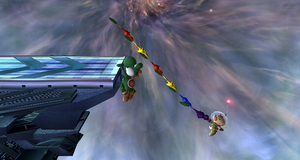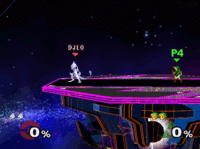Edgehogging: Difference between revisions
No edit summary |
MHStarCraft (talk | contribs) No edit summary |
||
| Line 1: | Line 1: | ||
{{ArticleIcons| | {{ArticleIcons|allgames=y}} | ||
[[Image:Edge Hog.png|thumb|right|Edge-hogging prevents [[tether recovery|tether recoveries]] from grabbing on to ledges.|300px]] | [[Image:Edge Hog.png|thumb|right|Edge-hogging prevents [[tether recovery|tether recoveries]] from grabbing on to ledges.|300px]] | ||
[[File:Runoffteleport.gif|thumb|{{SSBM|Mewtwo}} quickly edgehogging in ''Melee'' by running off the stage and using [[Teleport]] in the opposite direction to grab the [[edge]].]] | [[File:Runoffteleport.gif|thumb|{{SSBM|Mewtwo}} quickly edgehogging in ''Melee'' by running off the stage and using [[Teleport]] in the opposite direction to grab the [[edge]].]] | ||
Revision as of 13:36, September 21, 2013

Edge-hogging is the act of holding onto a ledge so that a recovering opponent cannot grab it. It is a form of edge-guarding. Casual players tend to say the idea is cheap but professionals agree that it is a critical part of recovery disruption.
In Super Smash Bros., certain characters, such as Fox, can use the turn-around animation out of a dash to move off the ledge and turn-around quickly to prepare an edge-hog.
The most common method of edge-hogging in Melee's competitive play is to wavedash back while near the edge, which should result with the characters sliding off of the stage, falling a short distance, and then quickly grabbing the edge. The character then usually uses the invincibility from the edge to avoid being hit by the opponent's recovery move. Other methods include moonwalking, doing a reverse neutral special then sliding off, using certain attacks which allow one to grab the edge faster or while attacking (i.e. Bowser's Whirling Fortress), or simply short hopping back and grabbing the edge. Another method, called the pivot edge-hog, involves pivoting very close to the ledge. The character will skid short distance during the turn-around animation and land on the ledge.
During the edge-hog, smashers typically roll from the ledge as it grants them invulnerability to the recovering opponent's attacks (usually up special) while still retaining possession of the ledge, in addition to usually lasting the longest of all actions and so hogging the edge for longer.
Edge-hogging in Melee earns one the "Edgehogger" bonus. The bonus is earned whenever one character is holding an edge and someone else moves into a spot where they can otherwise grab it, regardless of whether the edgehogged character is KO'd.
While it is easier to grab ledges in Brawl, successful edge-hogging requires better timing because the player can no longer edge-hog their opponent by rolling to the stage from the ledge because rolling off the ledge does not occupy the ledge. As a result, some players use hugging to edge-hog their opponents when they aim their recovery move to the ledge. However, edge hogging should be done with precise timing and caution, because if one miss-times the edge hog, the invincibility will wear off and the edge hogger can be attacked, mostly by a deadly stage spike.
It is important to remember that credit for an edge-hogged KO will still go the the player who most recently damaged the victim, not necessarily the edge-hogger. As a result edge-hogging in time matches does not directly benefit the hogger.
